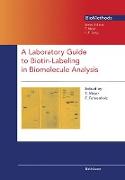- Start
- A Laboratory Guide to Biotin-Labeling in Biomolecule Analysis
A Laboratory Guide to Biotin-Labeling in Biomolecule Analysis
Angebote / Angebote:
ceptor-Binding Assay ................................................. 57 3.3 Results and Discussion. . . . . . . . . . . . . . . . . . . . . . . . . . . . . . . . . .. . . 58 . . . . . . . . . . . . . 3.4 Troubleshooting ....................................................... 61 Impurity in PACAP27-Cys-NH............................................ 61 2 Low specific activity of the PACAP receptor despite a single band ............. 62 Acknowledgments ..................................................... 62 References . . . . . . . . . . . . . . . . . . . . . . . . . . . . . . . . . . . . . . . .. . . 63 . . . . . . . . . . . . . . . . . Photoreactive Biotinylated Peptide Ligands for Affinity Labeling ......... " 65 Summary ............................................................. 65 4.1 Introduction................................................ . . . . . . . .. . 66 . 4.2 Technical Procedures ................................................. " 67 Synthesis of a trifunctional photoactivatable biotinylating reagent ............. 67 Synthesis of photo reactive biotinylated peptide hormones ................... 67 Site-specific incorporation of biotin and photo labels in separate steps ........ 69 Photoaffinity labeling ................................................... 72 4.3 Results and Discussion .................................................. 76 Synthesis of photoactivatable insulins with permanent biotin labels ............ 76 Applications: Insulin .................................................... 78 VI Examples for other applications .......................................... 78 4.4 Troubleshooting....................................................... 79 References . . . . . . . . . . . . . . . . . . . . . . . . . . . . . . . . . . . . . . . . . 81 . . . . . . . . . . . . . . . . . . .
Folgt in ca. 5 Arbeitstagen
